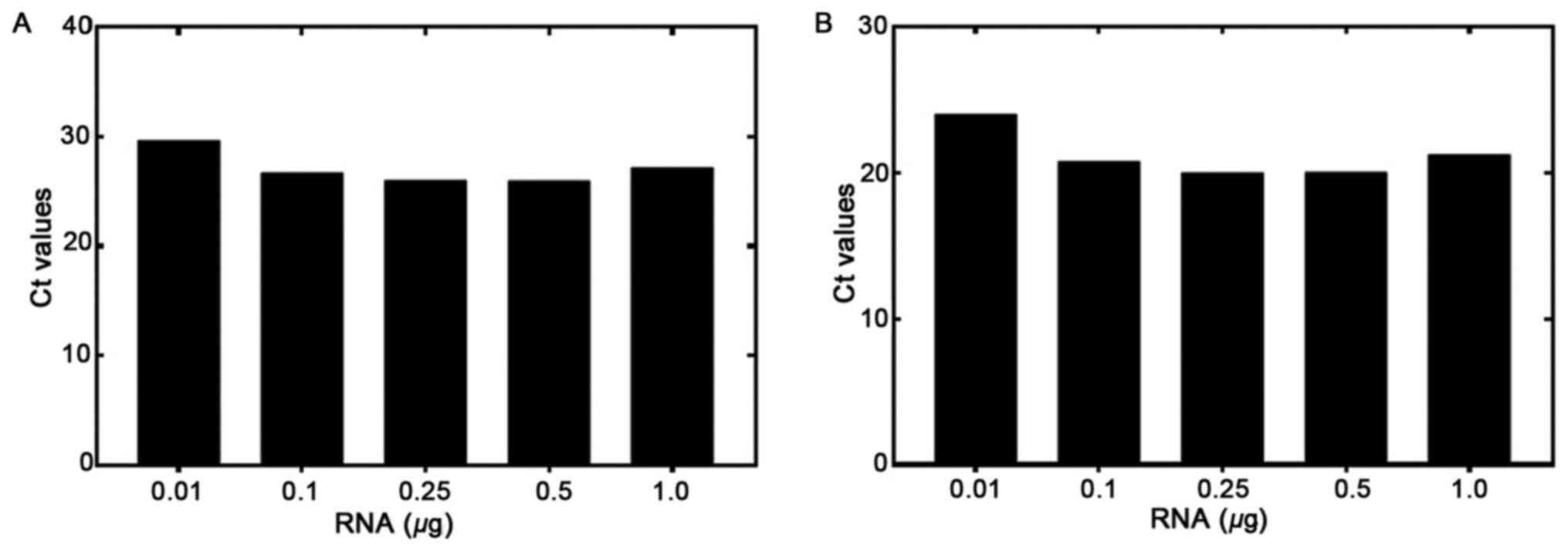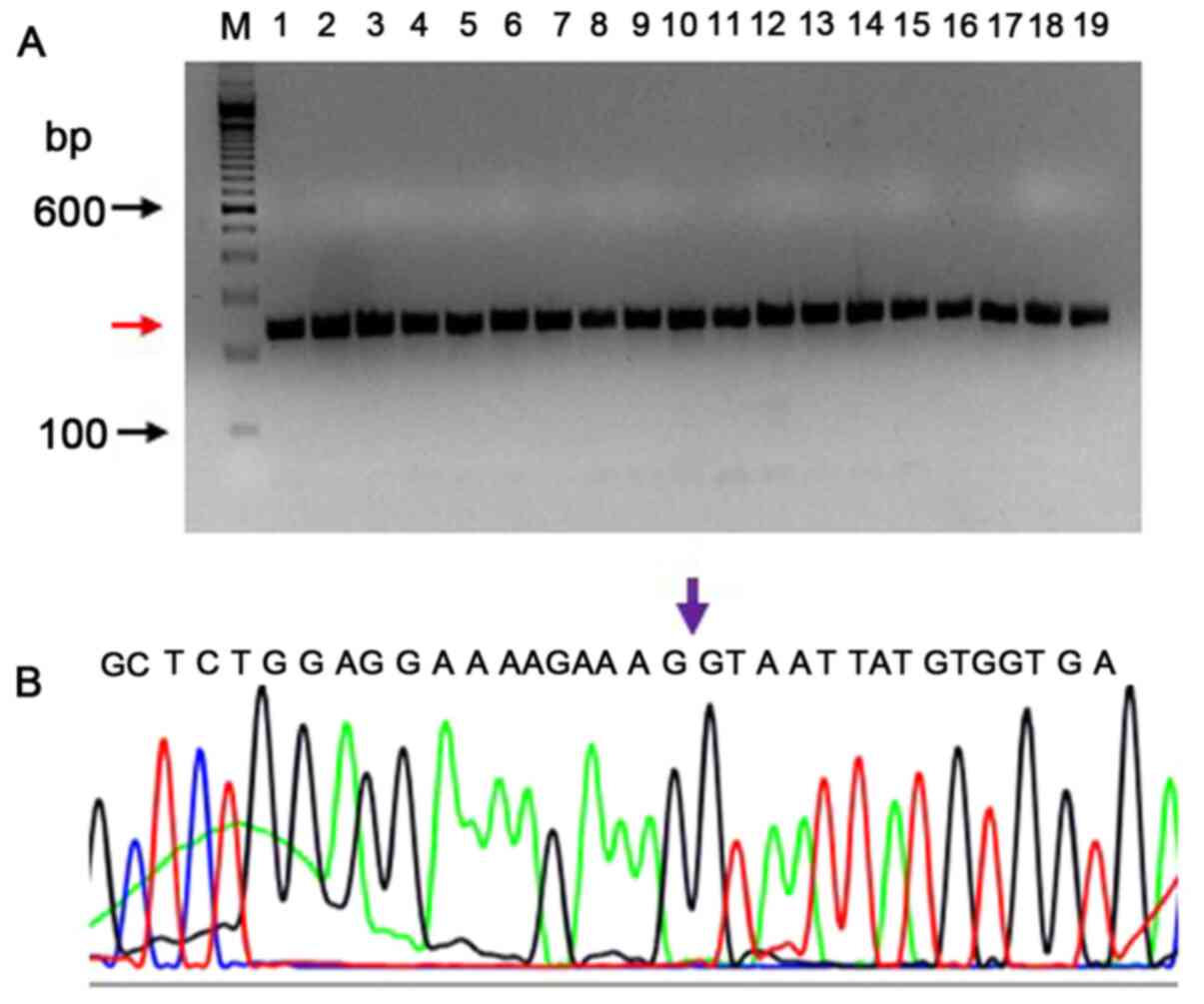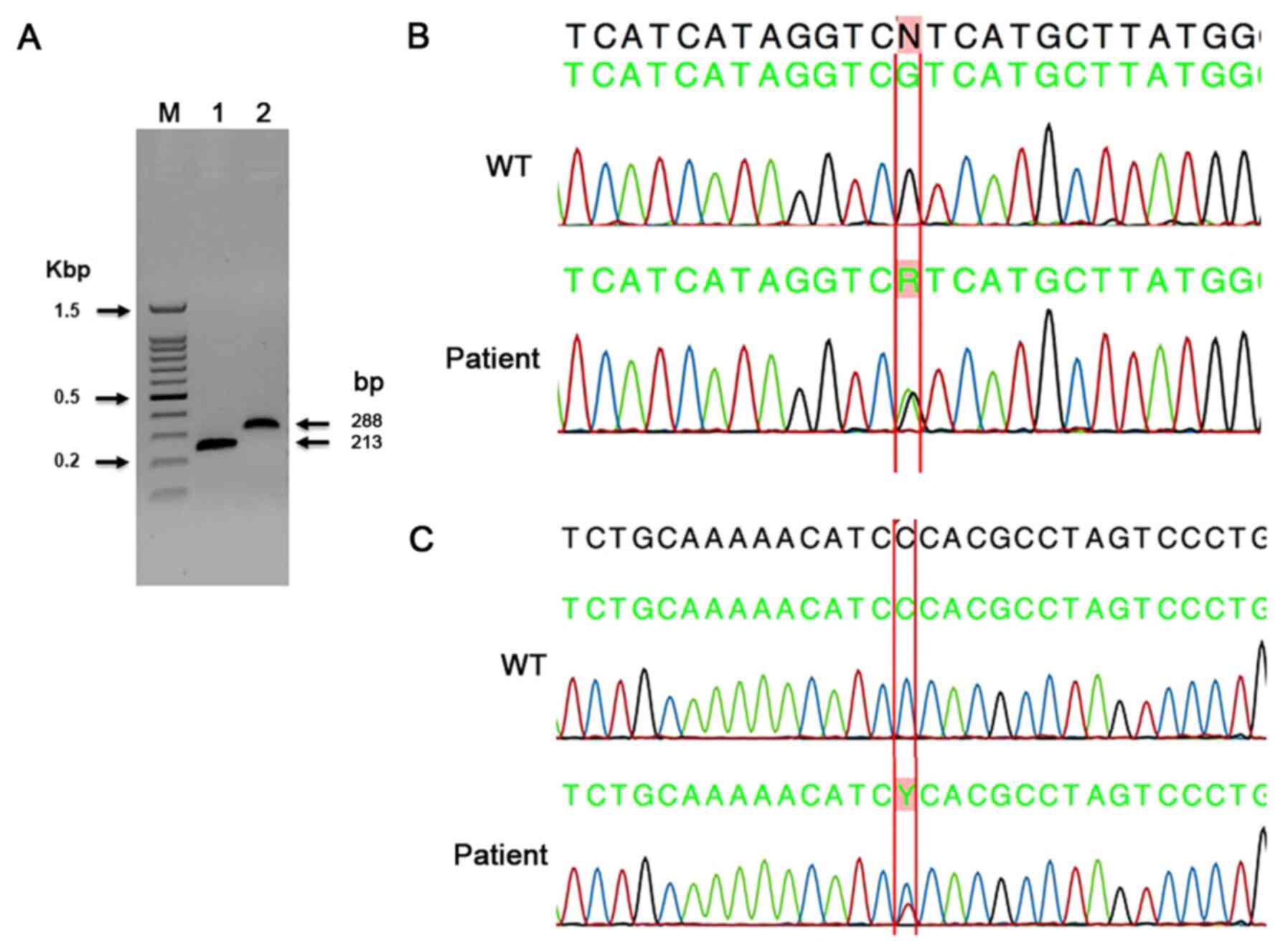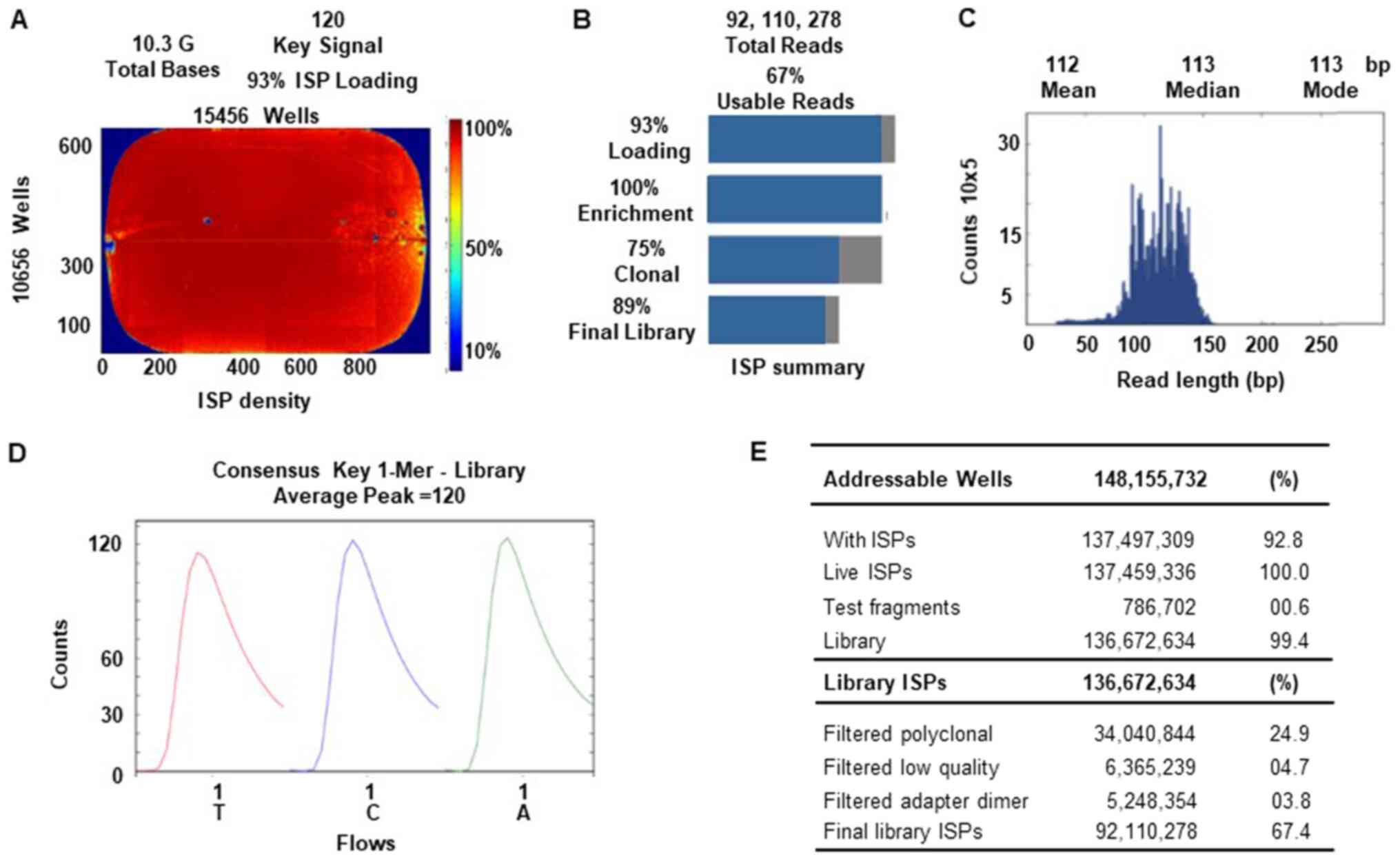|
1
|
Claussnitzer M, Cho JH, Collins R, Cox NJ,
Dermitzakis ET, Hurles ME, Kathiresan S, Kenny EE, Lindgren CM,
MacArthur DG, et al: A brief history of human disease genetics.
Nature. 577:179–189. 2020. View Article : Google Scholar : PubMed/NCBI
|
|
2
|
Sobel ME, Bagg A, Caliendo AM, Ladanyi M
and Zehnbauer B: The evolution of molecular genetic pathology:
Advancing 20th-Century diagnostic methods into potent tools for the
new millennium. J Mol Diagn. 10:480–483. 2008. View Article : Google Scholar : PubMed/NCBI
|
|
3
|
Shendure J, Findlay GM and Snyder MW:
Genomic medicine-progress, pitfalls, and promise. Cell. 177:45–57.
2019. View Article : Google Scholar : PubMed/NCBI
|
|
4
|
Weller M, Wick W, Aldape K, Brada M,
Berger M, Pfister SM, Nishikawa R, Rosenthal M, Wen PY, Stupp R and
Reifenberger G: Glioma. Nat Rev Dis Primers. 1:150172015.
View Article : Google Scholar : PubMed/NCBI
|
|
5
|
Ohgaki H, Dessen P, Jourde B, Horstmann S,
Nishikawa T, Di Patre PL, Burkhard C, Schüler D, Probst-Hensch NM,
Maiorka PC, et al: Genetic pathways to glioblastoma: A
population-based study. Cancer Res. 64:6892–6899. 2004. View Article : Google Scholar : PubMed/NCBI
|
|
6
|
Adamson C, Kanu OO, Mehta AI, Di C, Lin N,
Mattox AK and Bigner DD: Glioblastoma multiforme: A review of where
we have been and where we are going. Expert Opin Investig Drugs.
18:1061–1083. 2009. View Article : Google Scholar : PubMed/NCBI
|
|
7
|
Delgado-Lopez PD and Corrales-Garcıa EM:
Survival in glioblastoma: A review on the impact of treatment
modalities. Clin Transl Oncol. 18:1062–1071. 2016. View Article : Google Scholar : PubMed/NCBI
|
|
8
|
Ostrom QT, Cioffi G, Gittleman H, Patil N,
Waite K, Kruchko C and Barnholtz-Sloan JS: CBTRUS statistical
report: Primary brain and other central nervous system tumors
diagnosed in the United States in 2012–2016. Neuro Oncol. 21 (Suppl
5):v1–v100. 2019. View Article : Google Scholar : PubMed/NCBI
|
|
9
|
Balss J, Meyer J, Mueller W, Korshunov A,
Hartmann C and von Deimling A: Analysis of the IDH1 codon 132
mutation in brain tumors. Acta Neuropathol. 116:597–602. 2008.
View Article : Google Scholar : PubMed/NCBI
|
|
10
|
Yan H, Parsons DW, Jin G, McLendon R,
Rasheed BA, Yuan W, Kos I, Batinic-Haberle I, Jones S, Riggins GJ,
et al: IDH1 and IDH2 mutations in gliomas. N Engl J Med.
360:765–773. 2009. View Article : Google Scholar : PubMed/NCBI
|
|
11
|
Christensen BC, Smith AA, Zheng S,
Koestler DC, Houseman EA, Marsit CJ, Wiemels JL, Nelson HH, Karagas
MR, Wrensch MR, et al: DNA methylation, isocitrate dehydrogenase
mutation, and survival in glioma. J Natl Cancer Inst. 103:143–153.
2011. View Article : Google Scholar : PubMed/NCBI
|
|
12
|
van den Bent MJ, Dubbink HJ, Marie Y,
Brandes AA, Taphoorn MJ, Wesseling P, Frenay M, Tijssen CC, Lacombe
D, Idbaih A, et al: IDH1 and IDH2 mutations are prognostic but not
predictive for outcome in anaplastic oligodendroglial tumors: A
report of the European organization for research and treatment of
cancer brain tumor group. Clin Cancer Res. 16:1597–1604. 2010.
View Article : Google Scholar : PubMed/NCBI
|
|
13
|
Hanif F, Muzaffar K, Perveen K, Malhi SM
and Simjee ShU: Glioblastoma multiforme: A review of its
epidemiology and pathogenesis through clinical presentation and
treatment. Asian Pac J Cancer Prev. 18:3–9. 2017.PubMed/NCBI
|
|
14
|
Verhaak RG, Hoadley KA, Purdom E, Wang V,
Qi Y, Wilkerson MD, Miller CR, Ding L, Golub T, Mesirov JP, et al:
L Integrated genomic analysis identifies clinically relevant
subtypes of glioblastoma characterized by abnormalities in PDGFRA,
IDH1, EGFR, and NF1. Cancer Cell. 17:98–110. 2010. View Article : Google Scholar : PubMed/NCBI
|
|
15
|
Parsons DW, Jones S, Zhang X, Lin JC,
Leary RJ, Angenendt P, Mankoo P, Carter H, Siu IM, Gallia GL, et
al: An integrated genomic analysis of human glioblastoma
multiforme. Science. 321:1807–1812. 2008. View Article : Google Scholar : PubMed/NCBI
|
|
16
|
Frederick L, Wang XY, Eley G and James CD:
Diversity and frequency of epidermal growth factor receptor
mutations in human glioblastomas. Cancer Res. 60:1383–1387.
2000.PubMed/NCBI
|
|
17
|
Herbst RS and Shin DM: Monoclonal
antibodies to target epidermal growth factor receptor-positive
tumors. A new paradigm for cancer therapy. Cancer. 94:1593–1611.
2002. View Article : Google Scholar : PubMed/NCBI
|
|
18
|
Pelloski CE, Ballman KV, Furth AF, Zhang
L, Lin E, Sulman EP, Bhat K, McDonald JM, Yung WK, Colman H, et al:
Epidermal growth factor receptor variant III status defines
clinically distinct subtypes of glioblastoma. J Clin Oncol.
25:2288–2294. 2007. View Article : Google Scholar : PubMed/NCBI
|
|
19
|
Wong AJ, Ruppert JM, Bigner SH, Grzeschik
CH, Humphrey PA, Bigner DS and Vogelstein B: Structural alterations
of the epidermal growth factor receptor gene in human gliomas. Proc
Natl Acad Sci USA. 89:2965–2969. 1992. View Article : Google Scholar : PubMed/NCBI
|
|
20
|
Nishikawa R, Ji XD, Harmon RC, Lazar CS,
Gill GN, Cavenee WK and Huang HJ: A mutant epidermal growth factor
receptor common in human glioma confers enhanced tumorigenicity.
Proc Natl Acad Sci USA. 91:7727–7731. 1994. View Article : Google Scholar : PubMed/NCBI
|
|
21
|
Geisbrecht BV and Gould SJ: The human PICD
gene encodes a cytoplasmic and peroxisomal NADP (+)-dependent
isocitrate dehydrogenase. J Biol Chem. 274:30527–30533. 1999.
View Article : Google Scholar : PubMed/NCBI
|
|
22
|
Cairns RA and Mak TW: Oncogenic isocitrate
dehydrogenase mutations: Mechanisms models, and clinical
opportunities. Cancer Discov. 3:730–741. 2013. View Article : Google Scholar : PubMed/NCBI
|
|
23
|
Dang L, White DW, Gross S, Bennett BD,
Bittinger MA, Driggers EM, Fantin VR, Jang HG, Jin S, Keenan MC, et
al: Cancer-associated IDH1 mutations produce 2-hydroxyglutarate.
Nature. 462:739–744. 2009. View Article : Google Scholar : PubMed/NCBI
|
|
24
|
Zhao S, Lin Y, Xu W, Jiang W, Zha Z, Wang
P, Yu W, Li Z, Gong L, Peng Y, et al: Glioma-derived mutations in
IDH1 dominantly inhibit IDH1 catalytic activity and induce
HIF-1alpha. Science. 324:261–265. 2009. View Article : Google Scholar : PubMed/NCBI
|
|
25
|
Choi BD, Maus MV, June CH and Sampson JH:
Immunotherapy for glioblastoma: Adoptive T-cell strategies. Clin
Cancer Res. 25:2042–2048. 2019. View Article : Google Scholar : PubMed/NCBI
|
|
26
|
An Z, Aksoy O, Zheng T, Fan QW and Weiss
WA: Epidermal growth factor receptor and EGFRvIII in glioblastoma:
Signaling pathways and targeted therapies. Oncogene. 37:1561–1575.
2018. View Article : Google Scholar : PubMed/NCBI
|
|
27
|
Louis DN, Perry A, Reifenberger G, von
Deimling A, Figarella-Branger D, Cavenee WK, Ohgaki H, Wiestler OD,
Kleihues P and Ellison DW: The 2016 world health organization
classification of tumors of the central nervous system: A summary.
Acta Neuropathol. 131:803–820. 2016. View Article : Google Scholar : PubMed/NCBI
|
|
28
|
Steffensen KD, Waldstrøm M, Olsen DA,
Corydon T, Lorentzen KA, Knudsen HJ, Jeppesen U, Brandslund I and
Jakobsen A: Mutant epidermal growth factor receptor in benign,
borderline, and malignant ovarian tumors. Clin Cancer Res.
14:3278–3282. 2008. View Article : Google Scholar : PubMed/NCBI
|
|
29
|
Yoshimoto K, Dang J, Zhu S, Nathanson D,
Huang T, Dumont R, Seligson DB, Yong WH, Xiong Z, Rao N, et al:
Development of a real-time RT-PCR assay for detecting EGFRvIII in
glioblastoma samples. Clin Cancer Res. 14:488–493. 2008. View Article : Google Scholar : PubMed/NCBI
|
|
30
|
Golding SE, Rosenberg E, Khalil A, McEwen
A, Holmes M, Neill S, Povirk LF and Valerie K: Double strand break
repair by homologous recombination is regulated by cell
cycle-independent signaling via ATM in human glioma cells. J Biol
Chem. 279:15402–15410. 2004. View Article : Google Scholar : PubMed/NCBI
|
|
31
|
Golding SE, Morgan RN, Adams BR, Hawkins
AJ, Povirk LF and Valerie K: Pro-survival AKT and ERK signaling
from EGFR and mutant EGFRvIII enhances DNA double-strand break
repair in human glioma cells. Cancer Biol Ther. 8:730–738. 2009.
View Article : Google Scholar : PubMed/NCBI
|
|
32
|
Lammering G, Hewit TH, Holmes M, Valerie
K, Hawkins W, Lin PS, Mikkelsen RB and Schmidt-Ullrich RK:
Inhibition of the type III epidermal growth factor receptor variant
mutant receptor by dominant-negative EGFR-CD533 enhances malignant
glioma cell radiosensitivity. Clin Cancer Res. 10:6732–6743. 2004.
View Article : Google Scholar : PubMed/NCBI
|
|
33
|
Patel KP, Barkoh BA, Chen Z, Ma D, Reddy
N, Medeiros LJ and Luthra R: Diagnostic testing for IDH1 and IDH2
variants in acute myeloid leukemia an algorithmic approach using
high-resolution melting curve analysis. J Mol Diagn. 13:678–686.
2011. View Article : Google Scholar : PubMed/NCBI
|
|
34
|
Mehrotra M, Duose DY, Singh RR, Barkoh BA,
Manekia J, Harmon MA, Patel KP, Routbort MJ, Medeiros LJ, Wistuba
II and Luthra R: Versatile ion S5XL sequencer for targeted next
generation sequencing of solid tumors in a clinical laboratory.
PLoS One. 12:e01819682017. View Article : Google Scholar : PubMed/NCBI
|
|
35
|
Ballester LY, Fuller GN, Powell SZ, Sulman
EP, Patel KP, Luthra R and Routbort MJ: Retrospective analysis of
molecular and immunohistochemical characterization of 381 primary
brain tumors. J Neuropathol Exp Neurol. 76:179–188. 2017.PubMed/NCBI
|
|
36
|
Taher MM, Hassan AA, Saeed M, Jastania RA,
Nageeti TH, Alkhalidi H, Dairi G, Abduljaleel Z, Athar M,
Bouazzaoui A, et al: Next generation DNA sequencing of atypical
choroid plexus papilloma of brain: Identification of novel
mutations in a female patient by Ion Proton. Oncol Lett.
18:5063–5076. 2019.PubMed/NCBI
|
|
37
|
Butt M, Alyami S, Nageeti T, Saeed M,
AlQuthami K, Bouazzaoui A, Athar M, Abduljaleel Z, Al-Allaf F and
Taher M: Mutation profiling of anaplastic ependymoma grade III by
Ion Proton by next generation DNA sequencing. F1000Res. 8:6132019.
View Article : Google Scholar : PubMed/NCBI
|
|
38
|
Sanson M, Marie Y, Paris S, Idbaih A,
Laffaire J, Ducray F, El Hallani S, Boisselier B, Mokhtari K,
Hoang-Xuan K and Delattre JY: Isocitrate dehydrogenase 1 codon 132
mutation is an important prognostic biomarker in gliomas. J Clin
Oncol. 27:4150–4154. 2009. View Article : Google Scholar : PubMed/NCBI
|
|
39
|
Lu Y, Kwintkiewicz J, Liu Y, Tech K, Frady
LN, Su YT, Bautista W, Moon SI, MacDonald J, Ewend MG, et al:
Chemosensitivity of IDH1-mutated gliomas due to an impairment in
PARP1-mediated DNA repair. Cancer Res. 77:1709–1718. 2017.
View Article : Google Scholar : PubMed/NCBI
|
|
40
|
Reitman ZJ and Yan H: Isocitrate
dehydrogenase 1 and 2 mutations in cancer: Alterations at a
crossroads of cellular metabolism. J Natl Cancer Inst. 102:932–941.
2010. View Article : Google Scholar : PubMed/NCBI
|
|
41
|
Hartmann C, Meyer J, Balss J, Capper D,
Mueller W, Christians A, Felsberg J, Wolter M, Mawrin C, Wick W, et
al: Type and frequency of IDH1 and IDH2 mutations are related to
astrocytic and oligodendroglial differentiation and age: A study of
1,010 diffuse gliomas. Acta Neuropathol. 118:469–474. 2009.
View Article : Google Scholar : PubMed/NCBI
|
|
42
|
Hayden JT, Frühwald MC, Hasselblatt M,
Ellison DW, Bailey S and Clifford SC: Frequent IDH1 mutations in
supratentorial primitive neuroectodermal tumors (sPNET) of adults
but not children. Cell Cycle. 8:1806–1807. 2009. View Article : Google Scholar : PubMed/NCBI
|
|
43
|
Mukasa A, Takayanagi S, Saito K, Shibahara
J, Tabei Y, Furuya K, Ide T, Narita Y, Nishikawa R, Ueki K and
Saito N: Significance of IDH mutations varies with tumor histology,
grade, and genetics in Japanese glioma patients. Cancer Sci.
103:587–592. 2012. View Article : Google Scholar : PubMed/NCBI
|
|
44
|
Mellai M, Piazzi A, Caldera V, Monzeglio
O, Cassoni P, Valente G and Schiffer D: IDH1 and IDH2 mutations,
immunohistochemistry and associations in a series of brain tumors.
J Neurooncol. 105:345–357. 2011. View Article : Google Scholar : PubMed/NCBI
|
|
45
|
Yang H, Ye D, Guan KL and Xiong Y: IDH1
and IDH2 mutations in tumorigenesis: Mechanistic insights and
clinical perspectives. Clin Cancer Res. 18:5562–5571. 2012.
View Article : Google Scholar : PubMed/NCBI
|
|
46
|
Alassiri AH, Alkhaibary A, Al-Sarheed S,
Alsufani F, Alharbi M, Alkhani A and Aloraidi A:
O6-methylguanine-DNA methyltransferase promoter
methylation and isocitrate dehydrogenase mutation as prognostic
factors in a cohort of Saudi patients with glioblastoma. Ann Saudi
Med. 39:410–416. 2019. View Article : Google Scholar : PubMed/NCBI
|
|
47
|
Wang J, Zhao Y, Li JF, Guo CC, Chen FR, Su
HK, Zhao HF, Long YK, Shao JY, To Ss and Chen ZP: IDH1 mutation
detection by droplet digital PCR in glioma. Oncotarget.
6:39651–39660. 2015. View Article : Google Scholar : PubMed/NCBI
|
|
48
|
Shin H, Sa JK, Bae JS, Koo H, Jin S, Cho
HJ, Choi SW, Kyoung JM, Kim JY, Seo YJ, et al: Clinical targeted
next-generation sequencing panels for detection of somatic variants
in gliomas. Cancer Res Treat. 52:41–50. 2020. View Article : Google Scholar : PubMed/NCBI
|
|
49
|
Ali MAM, Ahmed EK, Assem MMA and Helwa R:
The synonymous isocitrate dehydrogenase 1 315C>T SNP confers an
adverse prognosis in egyptian adult patients with
NPM1-/CEBPA-negative acute myeloid leukemia. Indian J Hematol Blood
Transfus. 34:240–252. 2018. View Article : Google Scholar : PubMed/NCBI
|
|
50
|
Wang HY, Tang K, Liang TY, Zhang WZ, Li
JY, Wang W, Hu HM, Li MY, Wang HQ, He XZ, et al: The comparison of
clinical and biological characteristics between IDH1 and IDH2
mutations in gliomas. J Exp Clin Cancer Res. 35:862016. View Article : Google Scholar : PubMed/NCBI
|
|
51
|
Wartenberg M, Cibin S, Zlobec I, Vassella
E, Eppenberger-Castori S, Terracciano L, Eichmann MD, Worni M,
Gloor B, Perren A and Karamitopoulou E: Integrated Genomic and
Immunophenotypic classification of pancreatic cancer reveals three
distinct subtypes with prognostic/predictive Significance. Clin
Cancer Res. 24:4444–4454. 2018. View Article : Google Scholar : PubMed/NCBI
|
|
52
|
Watanabe T, Nobusawa S, Kleihues P and
Ohgaki H: IDH1 mutations are early events in the development of
astrocytomas and oligodendrogliomas. Am J Pathol. 174:1149–1153.
2009. View Article : Google Scholar : PubMed/NCBI
|
|
53
|
Nobusawa S, Watanabe T, Kleihues P and
Ohgaki H: IDH1 mutations as molecular signature and predictive
factor of secondary glioblastomas. Clin Cancer Res. 15:6002–6007.
2009. View Article : Google Scholar : PubMed/NCBI
|
|
54
|
Wikstrand CJ, McLendon RE, Friedman AH and
Bigner DD: Cell surface localization and density of the
tumor-associated variant of the epidermal growth factor receptor,
EGFRvIII. Cancer Res. 57:4130–4140. 1997.PubMed/NCBI
|
|
55
|
Johnson LA, Scholler J, Ohkuri T, Kosaka
A, Patel PR, McGettigan SE, Nace AK, Dentchev T, Thekkat P, Loew A,
et al: Rational development and characterization of humanized
anti-EGFR variant III chimeric antigen receptor T cells for
glioblastoma. Sci Transl Med. 7:275ra222015. View Article : Google Scholar : PubMed/NCBI
|
|
56
|
Heimberger AB, Sun W, Hussain SF, Dey M,
Crutcher L, Aldape K, Gilbert M, Hassenbusch SJ, Sawaya R,
Schmittling B, et al: Immunological responses in a patient with
glioblastoma multiforme treated with sequential courses of
temozolomide and immunotherapy: Case study. Neuro Oncol. 10:98–103.
2008. View Article : Google Scholar : PubMed/NCBI
|
|
57
|
Binder DC, Ladomersky E, Lenzen A, Zhai L,
Lauing KL, Otto-Meyer SD, Lukas RV and Wainwright DA: Lessons
learned from rindopepimut treatment in patients with
EGFRvIII-expressing glioblastoma. Transl Cancer Res. 7 (Suppl
4):S510–S513. 2018. View Article : Google Scholar : PubMed/NCBI
|
|
58
|
Kwatra MM: A rational approach to target
the epidermal growth factor receptor in glioblastoma. Curr Cancer
Drug Targets. 17:290–296. 2017. View Article : Google Scholar : PubMed/NCBI
|
|
59
|
Kastenhuber ER, Huse JT, Berman SH,
Pedraza A, Zhang J, Suehara Y, Viale A, Cavatore M, Heguy A,
Szerlip N, et al: Quantitative assessment of intragenic receptor
tyrosine kinase deletions in primary glioblastomas: Their
prevalence and molecular correlates. Acta Neuropathol. 127:747–759.
2014. View Article : Google Scholar : PubMed/NCBI
|
|
60
|
Felsberg J, Hentschel B, Kaulich K,
Gramatzki D, Zacher A, Malzkorn B, Kamp M, Sabel M, Simon M,
Westphal M, et al: Epidermal growth factor receptor variant III
(EGFRvIII) positivity in EGFR-amplified glioblastomas: Prognostic
role and comparison between primary and recurrent tumors. Clin
Cancer Res. 23:6846–6855. 2017. View Article : Google Scholar : PubMed/NCBI
|
|
61
|
Carvalho PO, Uno M, Oba-Shinjo SM,
Rosemberg S, Wakamatsu A, da Silva CC, Teixeira MJ and Marie SK:
Activation of EGFR signaling from pilocytic astrocytomas to
glioblastomas. Int J Biol Markers. 29:e120–e128. 2014. View Article : Google Scholar : PubMed/NCBI
|
|
62
|
Wong A, Mitra S, Del Vecchio CA and
Skirboll S: Expression of EGFRvIII in brain tumor stem cells. J
Clin Oncol. 26 (Suppl 15):S2002. 2008. View Article : Google Scholar
|
|
63
|
Katsanis SH and Katsanis N: Molecular
genetic testing and the future of clinical genomics. Nat Rev Genet.
14:415–426. 2013. View Article : Google Scholar : PubMed/NCBI
|
|
64
|
Di Resta C, Galbiati S, Carrera P and
Ferrari M: Next-generation sequencing approach for the diagnosis of
human diseases: Open challenges and new opportunities. EJIFCC.
29:4–14. 2018.PubMed/NCBI
|
|
65
|
Liang A, Zhou B and Sun W: Integrated
genomic characterization of cancer genes in glioma. Cancer Cell
Int. 17:902017. View Article : Google Scholar : PubMed/NCBI
|
|
66
|
Jonsson P, Lin AL, Young RJ, DiStefano NM,
Hyman DM, Li BT, Berger MF, Zehir A, Ladanyi M, Solit DB, et al:
Genomic correlates of disease progression and treatment response in
prospectively characterized gliomas. Clin Cancer Res. 25:5537–5547.
2019. View Article : Google Scholar : PubMed/NCBI
|
|
67
|
Ceccarelli M, Barthel FP, Malta TM,
Sabedot TS, Salama SR, Murray BA, Morozova O, Newton Y, Radenbaugh
A, Pagnotta SM, et al: Molecular profiling reveals biologically
discrete subsets and pathways of progression in diffuse glioma.
Cell. 164:550–563. 2016. View Article : Google Scholar : PubMed/NCBI
|


















